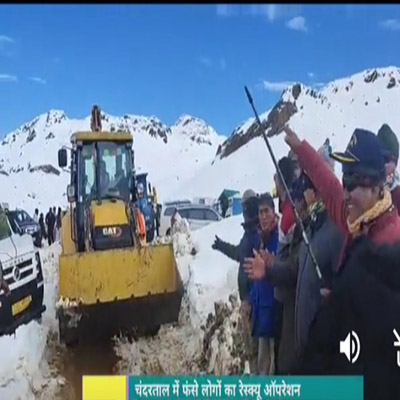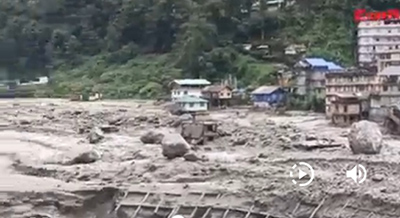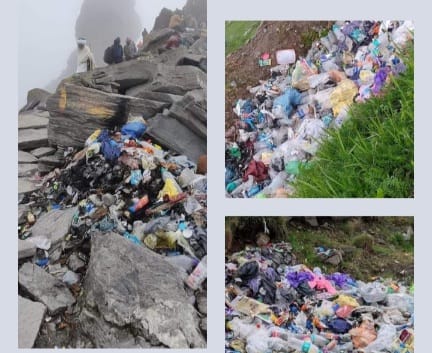SHIMLA/DEHRADUN/LEH: From Ladakh to Lahaul, from Tso Moriri to Gangotri and Subansiri , the retreating glaciers and snowfields in heart of Himalaya are under siege. Our Natural and Spiritual Heritage is in danger.
Ecologists are sounding the alarm, calling for a ban on prolonged camping in the forests and high-altitude regions to protect these vital ecosystems from the destructive effects of carbon footprints and aerosols.
These pollutants are accelerating the melting of glaciers and threatening the water towers of the Himalayas.
Dr. Milap C Sharma, a prominent geomorphologist and ecologist at JNU, who hails from Himachal, observed in his studies in Batal-Bara Shigri glacier site in Chandra Basin and Gangotri site that human activities, such as traffic and extended camping at high elevations, contribute significantly to the additional aerosol and black carbon, pushing the glaciers to melt faster than their natural cycle.
He suggests implementing a policy to ban camping in forests above 3,800 meters.

Not only this, we need to regulate an ban hydropower projects in the high altitude region.
Dr. Sher Singh Samant, former Director of the Himalayan Forest Research Institute (ICFRE), stresses the urgency of restoring ecosystems to ensure recovery.
"If we continue on this path," he warns, "human existence will be in danger. We are destroying the ecosystems and our livelihoods." Dr Samant said.
The Himalayan states, including the Union Territories of Ladakh and Jammu and Kashmir, have allowed camping sites in eco-sensitive high-altitude regions, ignoring the plight of the retreating glaciers, streams, and lakes.
What we are witnessing: Increasing incidents of extreme weather events like cloud bursts, Formation of Glacial Lake and Glacial Lake Outbursts Floods(GLoF) and avalanches.

There are now thousands of small and big glacial lakes in the high Himalaya.
These are more or less perceived to be the manmade phenomenon, battering our sacred mountain tops ranging from Ladakh to Lahaul and Sikkim almost every, risking and killing innocent locals downstream.
The fragile ecosystem of Chandratal Lake, perched at over 4,100 meters, is a prime example.
Revelers and camp walas swim in the lake, cook, and cater, increasing CO2 emissions and aerosols. These activities lead to rise in temperatures in these high-altitude regions.
Camping sites in sacred pilgrimage locations across Ladakh, Uttarakhand, and the Northeast are similarly affected.
Waste is dumped in hidden rocks, streams, and nallahs or burned, adding to the aerosols and carbon footprints, further accelerating glacier melt.
Despite the clear environmental threat, there is little regulation from local administrations or the state Tourism and Forest Departments.
From Miyar Valley and Neel Kanth to Batal and Bara Shigri Glacier sites to Auli in Uttarakhand and Tso Moriri in Ladakh, camping sites thrive.
These concerns are also articulated in a groundbreaking global study published in the journal *Nature*. As many as top 39 scientists from around the world examined 46 different glacier retreat sites across five continents.
They find that these sites are now giving rise to the ice-free ecosystems due to climate change.
They looked at soil properties, climate, plant and animal life, and overall biodiversity.
Dr. Milap Chand Sharma, a professor of geomorphology at JNU, New Delhi, was among these researchers.
Dr. Sharma, along with his student Dr. Pritam Chand, studied the Batal-Bara Shigri glacier site in Himachal Pradesh, the largest glacier in the region.

Their research highlights the importance of records from the supposed Little Ice Age remains for recent reconstruction.
Dr. Sharma's plant succession studies at the Gangotri glacier further illuminate the differences in ecological development due to varying climatic conditions in different glacier regions of the Himalayas.
The study found that as glaciers retreat, all environmental aspects change over time, with temperature playing a key role in soil nutrient buildup.
The study bode ill for the retreating glaciers, there is some hope.
The landlocked Batal-Bara Shigri glacier site, a source of the Chandra River located in the cold desert of the Chandra Basin, is predicted to last longer than others just because there is little human activity there.
But the prolonged camping sites nearby Chandertal is a cause for not only for this Ramser site, but also for these retreating glaciers.
The call to action is clear: to preserve the natural and spiritual heritage of the Himalayas, it is imperative to regulate and limit human activities in these sensitive ecosystems.















